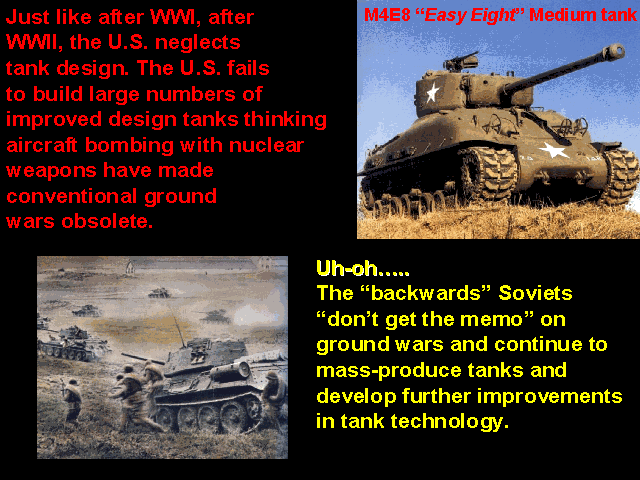
|








|
Slide 10 of 24
How did we get the "Feast/Famine" Ultra-Light, Ultra-Heavy U.S. Army?
The Army has undergone many major organizational changes since the end of World War II. Many theorists like Lieutenant General James Gavin in his book, "Airborne Warfare" in 1947 have called for air-delivered light tracked Armored Fighting Vehicles (AFVs) and even tracked landing gear aircraft to land them and their Paratroopers V/STOL to get us AIRMECHSTRIKE capabilities and free us from the limitations of the terrain. This would be the logical development of the U.S. Airborne experiences in WWII from "Seize and hold" towards operational maneuver from the air, combining the lessons of Airborne and Armored warfare into one, stronger whole. However the rush to demilitarize padded by the false sense of security the U.S. sole ownership of the nuclear bomb gave decision makers no sense of urgency to act on General Gavin's ideas. It took the North Korean invasion of South Korea to burst our "bubble" of complacency.
General Gavin asks: "Where was the Cavalry? ..and I don't Mean Horses"
After World War II, the Army fought the Korean War unexpectedly when the prevailing thought was nuclear weapons had made conventional conflicts out of the question. Once the Communists gained nuclear weapons of their own, a no-use of nuclear weapons stalemate followed, resulting in proxy nations of the Communists undertaking conventional or "limited wars". Without funding to modernize, the Army was organizationally, doctrinally and equipment-wise obsolete and almost identical to the World War II Army designed to battle in Europe. With a high proportion of its manpower wedded to wheeled vehicles bound to the roads, the Army was unable to stop massive cross country infiltration of asian peasant armies and took 3 years and 55,000 dead to turn the situation around via bold operational maneuver (General MacArthur's Inchon landings) and WWI-style fortifications and track-laying tanks used in close support of infantry attacks (General Ridgway's fire power tactics). In today's communications and satellite covered world its doubtful that we could take the weeks we needed to mass a sea-based invasion force without the enemy realizing it and thwarting it. Even as far back as Korea, the newest generation of heavier M46 tanks designed for European battlefields were found to be too heavy and immobile for the steep rolling hills of Korea, the lighter, more mobile WWII M4A3E1 "Easy Eight" Sherman tanks were widely used in their place. What was needed was a terrain agile, light tracked AFV with a gun for infantry fire support. A lesson re-learned by the British Paratroopers in the 1982 Falklands war; it took their Battalion commander himself charging an enemy machine gun nest and winning the Victoria Cross-fatally to take Goose Green with heavy casualties...days later Scorpion light tanks were used to fire support another attack and casualties were light. But at least they learned and have kept light tanks in their force structure. We have not been as wise.
In the mid-1950s the "Pentomic" Army rather than fix itself tried to write-off an unpopular closed-terrain war (Korea) as an aberration and focus instead on the Cold war confrontation in Europe to organize the land force for nuclear combat by building widely dispersed semi-autonomous formations. Even Army apologists regard the "Pentomic" era as a stop-gap in light of the nuclear bomber "New Look" madness of the Eisenhower administration.
LTG Gavin details this situation in his 1958 book, "War and Peace in the Space Age".